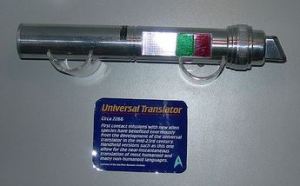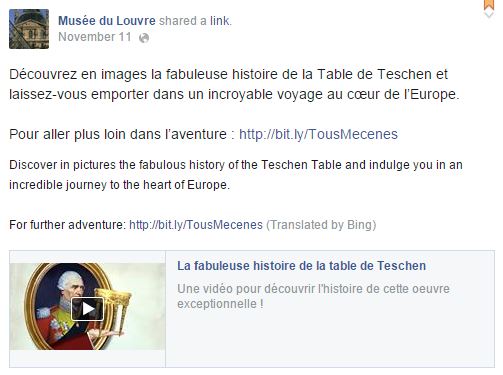Whether it’s a babel fish, telepathic field, protocol droid, or universal translator, science fiction is full of gadgets that break down the language barriers between characters, allowing everyone to comfortably express themselves and share knowledge with one another.

Photo from the Star Trek Experience by Cromely, cropped.
We may not yet have our jetpacks, but the future is rapidly approaching when it comes to universal translation. Just this year, Microsoft demoed realtime automatic translation with Skype Translator. A tiny, cloud-based, Bluetooth translation gadget called SIGMO reached 1,660% of its fundraising goal on IndieGoGo. Spoken-language translation apps are even available on mobile devices. Options for text-based translation have been around for years. But where do museums fall on this tech wave?

From the SIGMO press kit.
In many ways, major museums, with their diverse audiences and respected, innovative brands, would be ideal spaces to pilot technologies at the forefront of the translation revolution. However, many still use prerecorded tours in a few set languages or multilingual brochures. In the museum world, the private sector is leading the way. In Canada, Interpretour provides an app-based exhibit experience that is automatically translatable into 24 languages. Periplus is an audio guide development tool that generates text-to-speech narration and is exploring auto-translation options.
The revolution is already in progress on the web. Google Translate is the tool of choice for shifting to preferred languages on the Edinburgh Museums & Galleries’ website, and tech giants Google and Microsoft also offer automatic translation through browsers and third-party sites like Facebook.
A wider range of language options would engage more visitors from multilingual homes as well as from around the world, but automatic translation can miss nuances in language that human translators intuit. What do you think: should museums partner with tech companies to pilot automatic translation software, or should they stick with traditional methods?

I love combining SciFi with social/cultural ideas and issues – so I totally agree on Museums being at the perfect intersection to do just that!
However, have you found any issues with these institutions using Facebook or GoogleTranslate? Those translators tend to be fairly inaccurate, so just curious!
Also, I read this yesterday and you’d probably enjoy it! http://www.vox.com/2014/11/16/7223107/science-fiction-matters
LikeLiked by 1 person
You know, I didn’t really see anything. In general, Google has come under fire occasionally for how it assigns words statistically, but I’m not sure of anything specific to museums. My guess is that by now everyone is so used to there being some variation in Bing/Google Translate that it’s just humorous when it comes out oddly. Google Translate in particular has been out for almost ten years and it’s done silly things all along… but it’d be really interesting to run a museum-specific study.
LikeLike
I would be interested in seeing an economic comparison, especially when it comes to smaller and midsize museums. Most of the midsize museums I’ve worked at have an interpreter “on call” and even though in-person translation can be expensive, the specialty software can also be expensive and it may be years before we have a visitor that needs it (as opposed to free software that may not be of high quality, as Mike mentions). I wonder if there’s been any research on whether visitors prefer an in-person translated guided tour to an app.
LikeLike
I definitely see the advantages to both a translating app and a live person in comparison with the one-sided pre-recorded audio guides. A translating app might run the risk of giving you truly awful/hilarious translations, but they do allow you to go through the museum at your own speed. On the other hand, a live person who speaks your language could allow for a more dynamic museum visit with Q & As and clearer, contextual translations, but (and?) might also guilt you into seeing more of the museum than you really wanted. Yad Vashem in Jerusalem offers both audio guides and guided tours in a number of languages. When I went, our group had a guided tour. Our tour guide gave us great information about the objects and history and I was grateful for the human touch in such an emotionally and spatially overwhelming museum. At the same time, it did take away from my usual self-driven wandering in a museum. I would think that, if museums don’t have the resources to offer translating software and live-person language tours, they should choose one or the other based on their museum’s subject matter and the desires of their audience. I will be interested to see how museums try to catch up with technology going forward.
LikeLike
I love the open ended question at the end. I know sometimes there can be a smaller range of choice with impersonal translators just like there is for the audio guides and print outs. When I went to Europe I was lucky that English is the common language among Europeans and many Brits and Americans travel in Europe so there was always an English tour is their were tours in different languages. There we usually Spanish, French and German tours too since these are also common languages among travelers but if I was say Russian or Chinese I would be out of luck for having a translator. The app based tech would not only allow for people to see things at their own pace but allow it to be accessible to more people of varied languages. I know language can be a barrier but it doesn’t always have to be
LikeLike